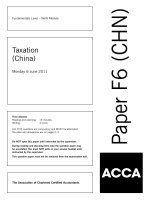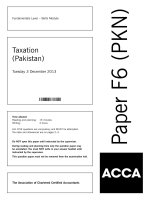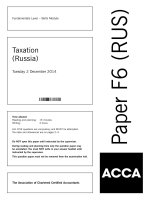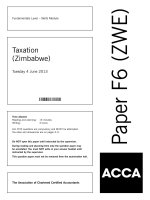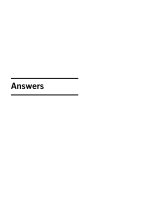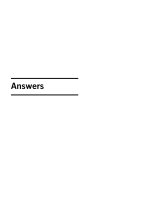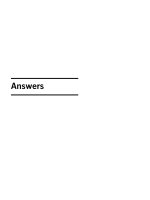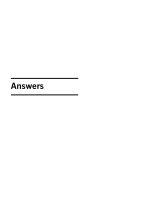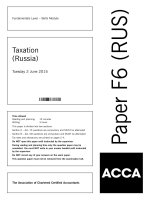ACCA f6 taxation romania 2014 jun question
Bạn đang xem bản rút gọn của tài liệu. Xem và tải ngay bản đầy đủ của tài liệu tại đây (270.11 KB, 12 trang )
Taxation
(Romania)
Tuesday 3 June 2014
Time allowed
Reading and planning:
Writing:
15 minutes
3 hours
ALL FIVE questions are compulsory and MUST be attempted.
Tax rates and allowances are on pages 2–5.
Do NOT open this paper until instructed by the supervisor.
During reading and planning time only the question paper may
be annotated. You must NOT write in your answer booklet until
instructed by the supervisor.
This question paper must not be removed from the examination hall.
The Association of Chartered Certified Accountants
Paper F6 (ROM)
Fundamentals Level – Skills Module
SUPPLEMENTARY INSTRUCTIONS
1.
2.
3.
Calculations and workings should be made to the nearest lei, unless instructed otherwise.
All apportionments should be made to the nearest month.
All workings should be shown.
TAX RATES AND ALLOWANCES
Personal income tax
General tax rate
16%
Income from employment
Benefits
Limit for non-taxable gifts
Limit for non-taxable voluntary pension contributions paid by the employer
Deductions
Deduction allowed for voluntary pension contributions paid by the employee
150 lei/person/occasion
€400/year
€400/year
Personal deduction
Number of dependent
persons for the taxpayer
Below 1,000
Monthly gross income (MI) – lei
Between 1,000 and 3,000
Above 3,000
0 persons
250
MI – 1, 000
250 x 1 –
2, 000
0
1 person
350
MI – 1, 000
350 x 1 –
2, 000
0
2 persons
450
MI – 1, 000
450 x 1 –
2, 000
0
3 persons
550
MI – 1, 000
550 x 1 –
2, 000
0
4 persons and more
650
MI – 1, 000
650 x 1 –
2, 000
0
Note: The value of the personal deduction resulting from the calculation should be rounded up to 10 (e.g. both 212
and 217 should be rounded to 220).
Income from the sale of immovable property owned by an individual
For immovable properties sold less than three years from their acquisition
Income
Tax rate
Up to 200,000 lei
3%
Above 200,000 lei
6,000 lei + 2% of the amount exceeding 200,000 lei
For immovable properties sold in a timeframe longer than three years from their acquisition
Income
Tax rate
Up to 200,000 lei
2%
Above 200,000 lei
4,000 lei + 1% of the amount exceeding 200,000 lei
Income from renting
Lump-sum deductible expenses quota
25%
2
Copyright income
Lump-sum deductible expenses quota for:
– monumental works of art
– other
25%
20%
Self-employed income
The allowance accepted for public institutions’ employees
The limit of deductibility for protocol expenses
The limit of deductibility for compulsory subscription expenses
The limit of deductibility for subscription expenses
other than compulsory ones
The limit of deductibility for social expenses
Reference interest rate set by the Romanian National Bank for loans
denominated in lei
13 lei/day/person
2%
5%
2%
2%
4·25%
Investment income
Tax rate for capital gains from the sale of shares
Tax rate for interest received by individuals
Tax rate for dividends received by individuals
16%
16%
16%
Prize income
Tax rate for prize income
Non-taxable value
16%
600 lei/day/prize
Pension income
Non-taxable pension income
1,000 lei
Corporate income tax
General tax rate
Reference interest rate set by the Romanian National Bank
for loans denominated in lei
Maximum accepted interest rate set by the Tax Code for loans
denominated in foreign currency
Inflation rate for prepayments of corporate income tax
The allowance accepted for public institutions’ employees
Maximum value of deductible expenses for employees:
– voluntary pension contributions
– private healthcare insurance contributions
Maximum value of deductible expenses for subscriptions to
non-profit organisations other than those which are compulsory or due
to the chambers of commerce and to employers’ organisations
The limit of deductibility for protocol expenses
The limit of deductibility for social expenses
Maximum value of tax credit for sponsorship expenses
3
16%
4·25% p.a.
6% p.a.
3·5% p.a.
13 lei/day/person
€400/tax year/employee
€250/tax year/employee
€4,000/year
2%
2%
20% of the corporate income tax but
not more than 3‰ of sales revenue
[P.T.O.
Corporate income tax for very small companies
Tax rate
3%
Straight-line depreciation periods (for tax and accounting purposes)
Class of asset
Buildings
Machines and equipment
Computers
Cars
Period in years
50
10
3
5
Note: The straight-line depreciation method for the above periods should be used in all cases, except where a question
specifically indicates another method and/or period is to be used.
The minimum value of an asset for tax depreciation purposes is 2,500 lei.
Tax on dividends paid to legal persons
For dividends paid to legal persons resident in Romania, EU or
EFTA countries
For dividends paid to other non-residents
16% or 0%
16%
Social security and other insurance contributions
Employed persons
Social security fund
Healthcare insurance fund
Unemployment fund
Work accident fund
Health insurance indemnities fund
Fund for guaranteeing salary payments
Self-employed persons
Social security fund
Healthcare insurance fund
Unemployment fund
Work accident fund
Health insurance indemnities fund
Persons obtaining rent income
Healthcare insurance fund
Employee
10·5%
5·5%
0·5%
–
–
–
Employer
20·8%
5·2%
0·5%
0·15%–0·85%*
0·85%
0·25%
31·3%
5·5%
1%
0·15%–0·85%*
0·85%
5·5%
Persons obtaining intellectual property revenues and revenues based on Civil Code contracts
Social security fund
10·5%
Healthcare insurance fund
5·5%
Average monthly earnings
Minimum monthly salary
2,223 lei
800 lei
* The exact value will be specified in the question, where necessary.
Note: These rates should be used in answering the questions, irrespective of the time period the question refers to.
4
Value added tax (VAT)
Standard rate
Reduced rates
Annual threshold for VAT registration
Annual threshold for a monthly tax period
Annual threshold for applying the cash accounting scheme for VAT
24%
9% and 5%
220,000 lei
€100,000
2,250,000 lei
Exchange rate
Euro/lei
€1 = 4·50 lei
Note: This rate should be used in all cases except where a question specifically indicates another rate is to be used.
Interest and penalties
Interest rate for late tax payments
Penalty level for late tax payments
0·04%/day
0·02%/day
5
[P.T.O.
This is a blank page.
Question 1 begins on page 7.
6
ALL FIVE questions are compulsory and MUST be attempted
1
(a) Printer GmbH is a company established in Germany since 2000. In December 2013, Printer GmbH opened a
business office in Bucharest, having a team of five employees who will perform consultancy services for at least
the next five years. In January 2014, Printer GmbH started a construction site in Timisoara, Romania which is
planned to last for 36 months. Printer GmbH keeps separate accounting records for the construction site and the
office.
For the year 2014 Printer GmbH registered the following revenues and expenses, which do not include revenues
and expenses allocated by the head office:
Note
Revenues
Consultancy services
(1)
Cost of services in progress
(2)
Exchange differences
(3)
Total revenues (excluding allocations from head office)
Expenses
Depreciation
(4)
Gross salaries
(5)
Compulsory social contributions
Social expenses
(6)
Materials
(7)
Small inventory objects
(8)
Fuel
(9)
Sponsorship expenses
(10)
Repairs
(11)
Rent
(12)
Consultancy services
(13)
Interest
(14)
Exchange differences
(15)
Total expenses (excluding allocations from head office)
Bucharest office
lei
Timisoara construction
site
lei
900,000
–
2,500
902,500
–
1,658,800
–
1,658,800
50,400
180,000
54,000
3,000
25,000
14,960
12,000
20,000
4,000
30,000
200,000
16,200
4,800
614,360
–
480,000
144,000
12,000
400,000
–
584,400
–
9,000
38,400
–
10,000
–
1,677,800
Notes:
(1)
The consultancy services were all invoiced by the office in Bucharest to clients in Romania.
(2)
According to accounting rules, the construction site in Timisoara recorded as revenue the work in progress
performed, but not yet received by the beneficiary.
(3)
The revenue of 2,500 lei recorded from exchange rate differences relates to accounts receivables.
(4)
Starting from December 2013, the office in Bucharest has had two cars under finance lease contracts. Both
cars are less than 3,500 kg and have fewer than nine seats. Both cars are used by the general manager of
the office who uses them only for business purposes and for driving from his home in Bucharest to the office
and back. Public transportation is available for going from his home to the office and back. The depreciable
value of each car is 126,000 lei.
(5)
The office in Bucharest has five employees. The construction site in Timisoara employs 20 individuals.
(6)
At Easter, all employees received a present with a value of 600 lei/employee.
(7)
For the Bucharest office, materials represents office consumables; for the construction site, these are
construction materials. All purchases have proper supporting documents.
(8)
The Bucharest office bought two computers: one server on 18 February 2014 for 12,960 lei and one laptop
on 20 June 2014 for 2,000 lei. These computers were used from the date of their purchase. According to
Printer GmbH’s policy, these items were recorded straight to expenses as small inventory objects.
7
[P.T.O.
(9)
For the cars used by the Bucharest office, Printer GmbH spent 500 lei/car/month for fuel. From the start of
its operations, at the construction site in Timisoara, Printer GmbH used two trucks (each weighing more
than 3,500 kg) and one small car (weighing less than 3,500 kg and having fewer than nine seats). All
three construction site vehicles are rented from a Romanian company. The fuel expenses recorded in 2014
are 24,000 lei/truck/month and 700 lei/small car/month. The trucks are used for construction works and
proper log-books and supporting documents justify the expenses related to them. The small car is used by
the chief engineer for both business and personal journeys. All personal use is deducted from the engineer’s
salary.
(10) In June 2014, the Bucharest office sponsored one student job fair for 20,000 lei. A proper sponsorship
contract was signed.
(11) Repair services for the vehicles were as follows:
–
–
–
2,000 lei/car for each car used in Bucharest office
4,000 lei/truck for trucks used in Timisoara
1,000 lei/car for the small car used in Timisoara.
(12) A monthly rent of 2,500 lei was paid for the Bucharest office premises. For the vehicles used in Timisoara,
the rent is 1,200 lei/month/truck and 800 lei/month for the small car.
(13) To perform the consultancy services from its office in Bucharest, Printer GmbH used external consultants.
The total expense for these consultants was 200,000 lei, but Printer GmbH only has contracts and
time-sheets supporting expenses of 180,000 lei.
(14) The interest expense relates to the following:
–
–
–
Interest paid under the finance lease for the cars used by the Bucharest office of 300 lei/car/month.
Interest on a three-month bullet loan of 300,000 lei taken by Printer GmbH in January 2014 from a
Romanian individual to start its activity in Bucharest. The interest rate on this loan was 12% p.a. and
the loan was repaid in full in 2014. The individual does not grant loans as a professional lender and
he is not authorised by the National Romanian Bank for the granting of loans.
Interest on a loan of 100,000 lei taken by Printer GmbH from a Romanian resident bank for its
construction site in Timisoara. Interest of 10,000 lei was recorded on this loan in 2014.
(15) As the exchange rate fluctuated during the year, Printer GmbH recorded expenses in respect of exchange
rate differences for the finance lease contracts of 200 lei/month/car.
In addition to the above revenues and expenses, Printer GmbH issued a debit note to its two permanent
establishments in Romania. This related to expenses recorded in Germany by the head office in connection with
the activities performed in Romania, as follows:
Expense
Allocation basis
Marketing expenses
Advertisements published for each permanent
establishment and paid for by the head office
GPS expenses
The exact value of GPS tracking services paid
for by the head office for each vehicle (car or
truck) used by the permanent establishments.
The GPS tracking service cost is
100 lei/vehicle/month
Management expenses Total management expenses are split equally
between all of Printer GmbH’s permanent
establishments. No time-sheets or other
supporting documents were provided for this
expense
Total expenses allocated through debit note
8
Bucharest
Timisoara
office
construction site
lei
lei
12,200
13,500
2,400
3,600
30,000
30,000
44,600
47,100
Required:
(i)
Define the term ‘permanent establishment’ for tax purposes.
(1 mark)
(ii) Explain the rules for computing corporate income tax due in Romania by non-residents having multiple
permanent establishments in Romania.
(2 marks)
(iii) Compute the corporate income tax due by Printer GmbH in Romania for 2014.
Note: Ignore any VAT and/or benefit in kind implications.
(23 marks)
(b) Toner SRL is a company established in Romania, which has a permanent establishment in Germany. The
revenues and expenses recorded in 2014 by Toner SRL separately for each activity in Romania and through its
permanent establishment in Germany are as follows:
Romanian activity
Total taxable revenues
Total deductible expenses
Corporate income tax paid in Romania
Corporate income tax paid in Germany
lei
200,000
120,000
17,000
–
Permanent establishment
activity
lei
500,000
400,000
–
28,000
Romania and Germany have signed a tax treaty for the avoidance of double taxation.
Required:
Determine the corporate income tax due in Romania for Toner SRL’s cumulated activity, taking into account
any available tax relief.
(4 marks)
(30 marks)
9
[P.T.O.
2
Mr Ink is a Romanian citizen, resident in Brasov. He was employed by Pencils SRL, a limited liability company, also
based in Brasov but in May 2014 his employer announced that the position in which he worked would no longer
exist, and his employment contract would cease on 31 May 2014. Thus, the employment contract was ceased due
to reasons which were not connected with the employee’s person or activity. Mr Ink did not have any other job in the
period January to May 2014, so his basic activity in this period was with Pencils SRL. He also did not have any other
employment activity before the end of 2014.
In May 2014 Mr Ink received the following income and benefits from Pencils SRL:
(1) A basic salary of 2,500 lei.
(2) A performance bonus of 300 lei.
(3) Meal vouchers of 9·35 lei/voucher. All the meal vouchers given by Pencils SRL comply with the limitations
imposed by the law.
(4) Compensation payment, in accordance with the employment contract, of 12,500 lei.
(5) An Easter present of 500 lei/child for each of his two children.
May 2014 had 20 working days, out of which Mr Ink spent three days on a business trip in Timisoara. For this
business trip Mr Ink received a daily allowance of 100 lei/day. Pencils SRL also paid for Mr Ink’s accommodation and
travel of 1,700 lei, for which proper invoices are provided.
Mr Ink’s wife, Mrs Ink, is also employed by Pencils SRL. Her basic salary is 2,000 lei per month and she also receives
meal vouchers of 9·35 lei/voucher, which comply with the relevant legal provisions. In May 2014, Mrs Ink worked
all 20 working days at the compay’s premises. Mrs Ink continued to work for Pencils SRL during the whole of 2014.
Mr and Mrs Ink have two children: a daughter who is 16 years old and has no income, and a son who is 17 years
old and is employed at a gross monthly salary of 800 lei. The children are considered dependent persons under the
care of Mrs Ink.
In March 2014, Mr Ink made an agreement with a local magazine to publish some economic analysis articles. For
these articles Mr Ink will receive gross revenue of 1,000 lei/article as intellectual property income. This income is
payable on the last day of the month in which the article is published. In 2014 Mr ink published three articles: two
articles in April 2014 and one article in November 2014. Mr Ink made the option to request the local magazine to
withhold final income tax from this income.
Required:
(a) Calculate, with explanations, the personal income tax due for the employment income received by Mr and
Mrs Ink in May 2014.
(13 marks)
(b) Calculate, with explanations, the social contributions due by Pencils SRL for Mr and Mrs Ink for May 2014
assuming that Pencils SRL has no other employees.
Note: The work accident fund contribution rate is 0·15%.
(7 marks)
(c) Calculate, with explanations, the income tax and social contributions due to be withheld by the local
magazine from Mr Ink’s intellectual property income in 2014.
(5 marks)
(25 marks)
10
3
Mrs Paper is a Romanian citizen, resident in Bucharest. In January 2014, Mrs Paper started a self-employed business
trading in bread. Mrs Paper did not register for value added tax (VAT) on the establishment of her business.
Mrs Paper sells 30,000 units of bread each month at a price of 1 leu/unit. The acquisition price of the bread is
0·9 lei/unit (inclusive of VAT). All acquisitions are made from suppliers registered for VAT in Romania. At the end of
each month Mrs Paper keeps an inventory of 100 units of bread.
In February 2014, Mrs Paper bought a building for use as her office and shop. The building was bought from a
company registered for VAT in Romania for 120,000 lei plus VAT of 28,800 lei. In March 2014, Mrs Paper bought
a computer from a company registered for VAT in Romania for 3,600 lei plus VAT of 864 lei.
Required:
(a) List any FOUR supplies to which the 9% reduced rate of value added tax (VAT) applies.
(b) (i)
(2 marks)
Determine when Mrs Paper should become a VAT registered person, clearly stating all relevant
deadlines.
(3 marks)
(ii) Compute the VAT adjustments which Mrs Paper should make on registration.
(7 marks)
(c) State, giving reasons, whether Mrs Paper should use a monthly or quarterly VAT period in 2014. (3 marks)
(15 marks)
4
Eraser SRL is a company resident in Romania, owned entirely by Mr Desk, a Romanian citizen. Eraser SRL was
established in 2013 with a share capital of 200 lei. During 2013, Eraser SRL applied the special scheme for corporate
income tax. On 31 December 2013, Eraser SRL registered total revenues of 128,000 lei. All revenues are sales
revenues from the company’s main activity – trading in IT items.
In 2014, Eraser SRL registered the following quarterly revenues and expenses:
Quarter 1
Quarter 2
Quarter 3
Quarter 4
(Q1) 2014 (Q2) 2014 (Q3) 2014 (Q4) 2014
lei/quarter lei/quarter lei/quarter lei/quarter
Revenues
155,000
160,000
123,500
250,000
IT sales
145,000
160,000
120,000
250,000
Consultancy
3,500
Insurance compensation for loss of inventory 10,000
Expenses
104,200
122,800
73,400
202,500
Merchandise
101,000
120,000
70,000
200,000
Energy and water
1,000
2,500
1,300
2,100
Protocol
2,000
2,000
Bank charges
200
300
100
400
TOTAL
2014
lei/year
688,500
675,000
3,500
10,000
502,900
491,000
6,900
4,000
1,000
Required:
(a) List the conditions to be fulfilled for a company to be able to enter the special scheme of corporate income
tax for very small companies at incorporation and at the beginning of each subsequent year.
(6 marks)
(b) Compute the corporate income tax due by Eraser SRL for each quarter of 2014, clearly explaining when and
why it can apply or must cease to apply the special scheme of corporate income tax for very small companies.
Note: Ignore any legal reserve requirement and any value added tax (VAT) implications. Final tax computation
is not required.
(9 marks)
(15 marks)
11
[P.T.O.
5
Mrs Staple has her domicile in Ploiesti, Romania. She is employed by Office SRL, a company resident in Bucharest
District 1, which qualifies as a small taxpayer, from a tax administration point of view. On 1 January 2014, Mrs Staple
rented an apartment in Bucharest, District 6, for which she pays a monthly rent of 2,500 lei. The rent is paid on the
last day of each month. From 1 January 2014, she used the apartment both to live in Bucharest and to provide
consultancy services as a self-employed activity, which is registered with the Trade Register in Bucharest. Mrs Staple
allocated 70% of the apartment area to her self-employed activity.
Mrs Staple kept her domicile in Ploiesti and rented out her Ploiesti apartment from 1 January 2014 to another
individual for a gross monthly rent of 1,000 lei. The rental contract is for a period of three years and will not change
during this period. Mrs Staple did not make any option as regards the taxation of this rent income, thus the standard
treatment will apply.
For her self-employed activity, Mrs Staple estimated her net revenue for 2014 at 40,000 lei. However, in all
12 months of 2014 she issued invoices to her clients for consultancy services of 20,000 lei/month. She received
invoices from her suppliers of 15,000 lei/month. She managed to receive all her clients payments in the same month
as the invoices were issued and to pay her suppliers in the month following the month in which they were issued.
Required:
(a) For each of Mrs Staple’s sources of income in 2014, state, giving reasons, the competent authority to which
tax should be declared and paid and the person who is liable to declare and pay the tax.
(3 marks)
(b) Explain the procedure for declaring Mrs Staple’s rent income, together with the deadlines for declaring and
paying income tax and compulsory social contributions for 2014 (both prepayments and final computation),
and calculate the relevant amounts due.
(7 marks)
(c) Calculate the prepayments of tax due by Mrs Staple for her self-employed activity in 2014 and state the
deadlines for paying them, together with the amount payable at each deadline.
(2 marks)
(d) Calculate the final tax due by Mrs Staple for her self-employed activity in 2014 and the amount to be paid
on end of year settlement, taking into account her prepayments of tax.
Note: Ignore any social contributions which may be due. Ignore any VAT implications.
(3 marks)
(15 marks)
End of Question Paper
12
